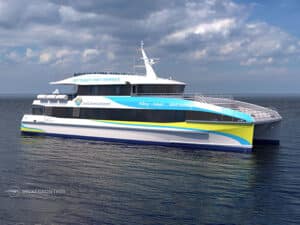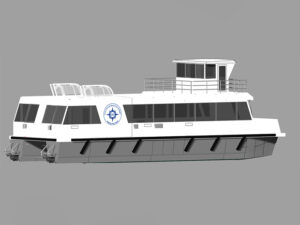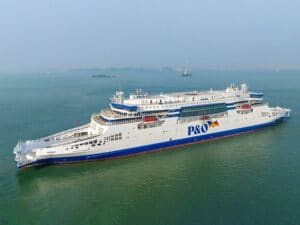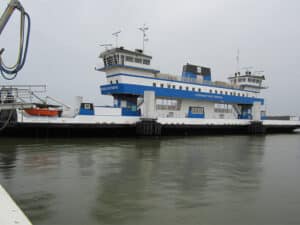
Incat Crowther cat is designed to deal with Danube debris
Written by Nick Blenkey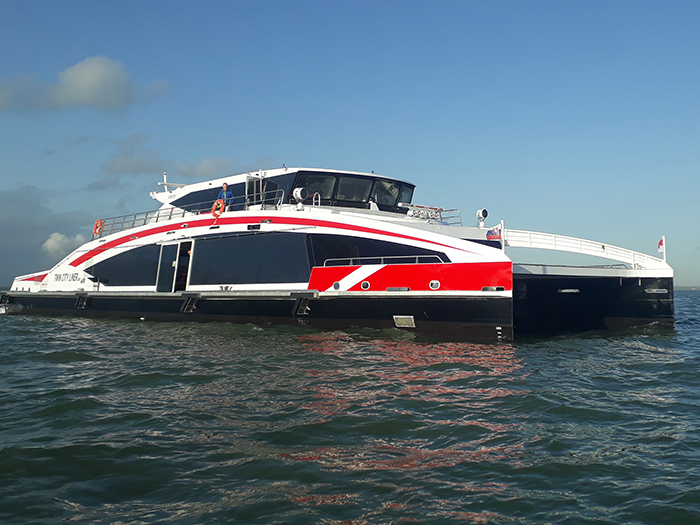
Low wash ferry is designed to deal with high currents, debris and other Danube challenges
Designer Incat Crowther has released some more details on the 39 m low wash, high-speed catamaran ferry recently delivered by Britain’s Wight Shipyard to Danube River operator Twin City Liner (see earlier story).
The vessel meets stringent design criteria for operation on the Danube. The design features a low draft of 0.8 m, minimal wake / wash, low air draft and a hull form designed for restricted waters where high current and debris are encountered. A retractable mast facilitates navigation and radar functions whilst fitting under low bridges.
The CFD-optimized, hull is highly efficient, giving the vessel a top speed of 40 knots and a reliable service speed of 32 knots at less than 70% MCR. The hull performs at level trim, affording maximum clearance under the keel for shallow areas of the river.
Passengers board Twin City Liner via midship doors port and starboard and enter a bright and airy main cabin with large windows, capable of seating up to 184 passengers. A kiosk providing a range of snacks and refreshments is provided aft on the starboard side. On the port side toilets are provided, one of which is for disabled customers.
Above, the upper deck is accessed from a centre staircase in the main cabin as well as two staircases aft on the open deck. Interior seating is available for 35 passengers, while external seating is provided for 29 passengers. Serving commuters as well as tourists, the vessel has space for 12 bikes on the aft deck. An extensive demisting system is fitted to windows to maintain clear views for passengers.
A customized anchoring system has been provided that may be used in very high current conditions. The anchors are stowed flush in custom pockets to prevent against external contact. Special consideration was made to the design of mooring and fendering systems to allow ease of docking in the narrow canals and high current of the Danube. Twin City Liner’s structural design uses advanced engineering to reduce weight whilst remaining robust. This is matched with durable, lightweight systems and interior fitted by Wight Shipyard, with the vessel coming in under the target weight.
The vessel is powered by four Scania DI16 main engines, each producing 809 kW, driving Rolls Royce S40-3 water jets. The quad propulsion train was chosen for improved redundancy and reduced maintenance, by allowing the engines to run at low MCR. Large hatches over the main engines and gearboxes enhance maintenance access.
PRINCIPAL DIMENSIONS | |
|---|---|
Length Overall | 130’ 3” / 39.7m |
Length Waterline | 125’ / 38.1m |
Beam Overall | 34’ 10” / 10.6m |
Draft (hull) | 2’ 8” / 0.8m |
Depth | 6’ 5” / 1.95m |
Construction | Marine grade aluminium |
CAPACITIES | |
Fuel Oil | 2 325 gallons / 8 800 litres |
Fresh Water | 159 gallons / 600 litres |
Sullage | 396 gallons / 1 500 litres |
Passengers | 248 |
Crew | 4 |
PROPULSION AND PERFORMANCE | |
Speed (Service) | 32 knots |
Speed (Max) | 40 knots |
Main Engines | 4 x Scania DI16 076M |
Power | 4 x 1085hp / 809kW @ 2300rpm |
Propulsion | 4 x Rolls Royce S40-3 Waterjets |
Generators | 2 x John Deere 4045 85hp |
REGULATORY | |
Flag | Austria |
Class | DNV-GL +1A HSLC R6 Passenger craft E0 |
EU Regulation | EU Directive 2006/87/EC |

